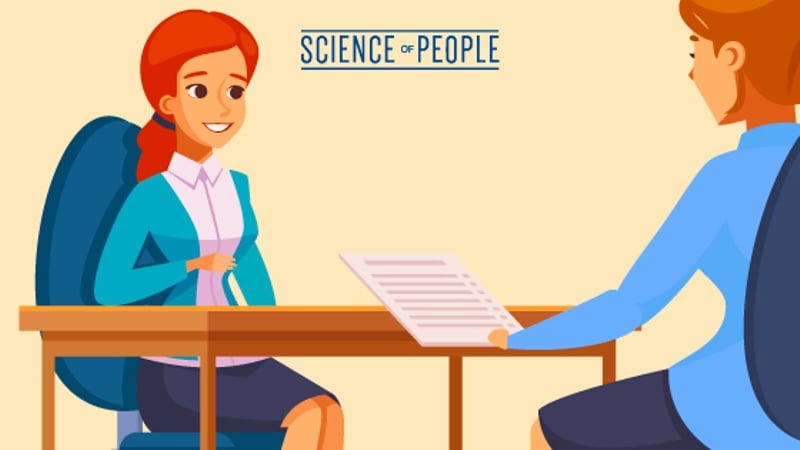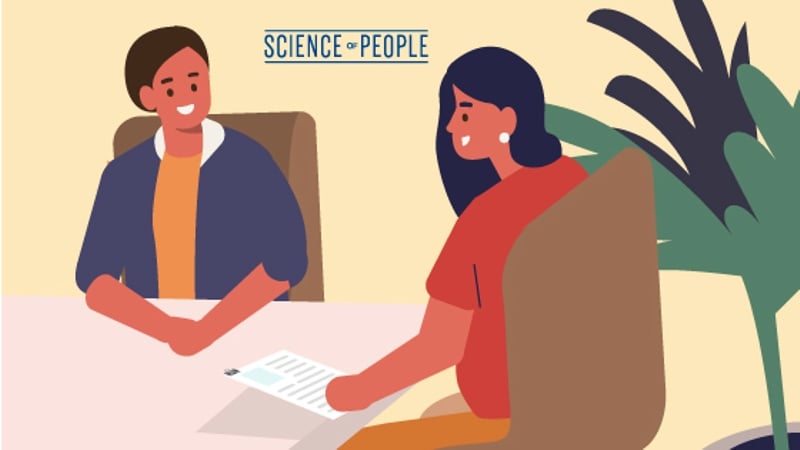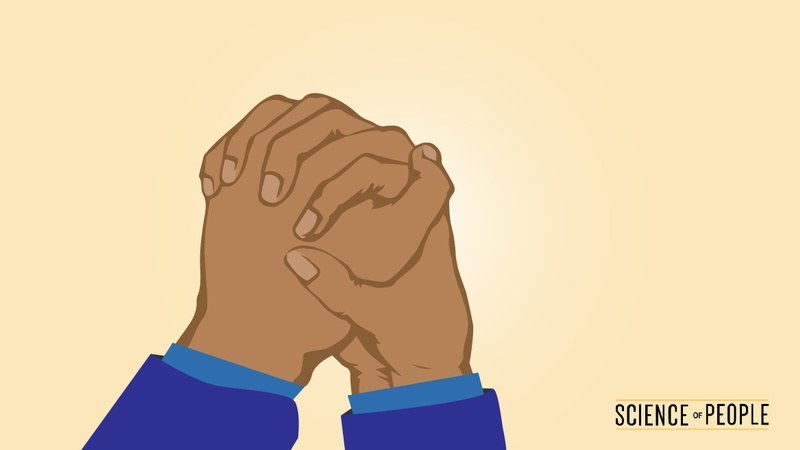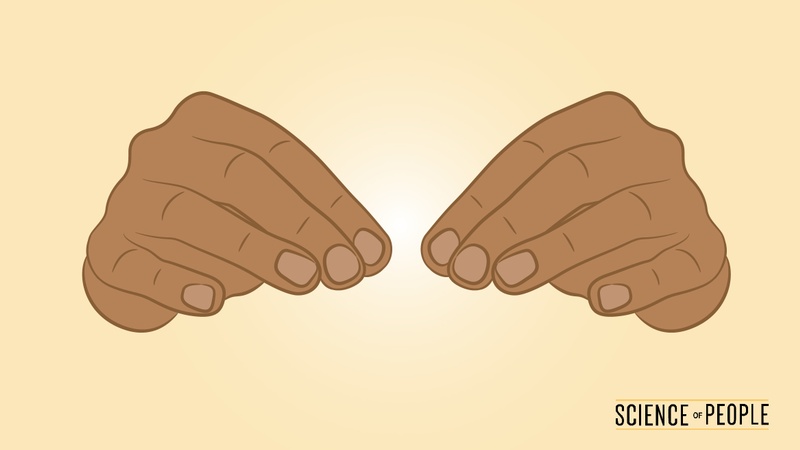This article is part of our body language guide. Click here for more.
Everyone gets a little nervous about job interviews. What should you do to prepare? Practice? Script answers to the interviewer’s potential questions? All good, but the most important thing you can do is prep your body language.
What you say is not as important as how you say it.
Are you communicating all of your best traits in an interview? What are your interview body language and nonverbal behavior saying to the interviewer? Here are a few tips to give you the extra body language edge to get the job and extra set of tips on what not to say in an Interview:
Don’t Block
If you bring your resumé to your interview—whether you’re in person or on Zoom—a common body language mistake people do is hold it right in front of them, like this:

Holding your resumé out front creates a barrier between you and the interviewer, breaking rapport. Instead of blocking yourself, hold your resumé out to the side:

Not only does it prevent the block, it also opens up your body naturally since your hands are out to the side. It makes you look friendlier and more relaxed.
Don’t Self-Touch
Are you a fidgeter? Fidgeting comes in many forms:
- playing with your fingers
- biting your nails
- picking at your lips or keyboard
- wiggling around your car keys or earrings
- adjusting your tie or watch
- spinning your ring on your finger
- bouncing your feet
Whatever you do, don’t bring your fidget spinner to the interview.
One recent survey1https://lifehacker.com/avoid-fidgeting-to-ace-your-next-job-interview-711096347 even found that hiring managers skipped hiring applicants 26% of the time because they fidgeted too much. That number may be a bit extreme, but if only those fidgeters knew what I’m about to tell you… they may have gotten the job.
Here’s my secret to controlling your fidgeting: learn to hide it.
Instead of fidgeting, try wiggling your toes. Nobody will know except you! Try to keep your hands empty. Holding pens and even your watch might tempt you to start fidgeting. And if you really want to get rid of that fidgeting for the long term, learn how to break that bad habit forever.
Pro Tip: Want to really master your video calls? Body language on video is harder to see—there’s lag, bad lighting, and the unfortunate case of some interviewers forgoing their pants. Don’t make these mistakes! Prep yourself with the ultimate guide to video calls here.
Relax With Your Hands On The Table
Most likely, you’ll be sitting at a desk or your office computer. When you’re not gesturing with your hands (or fidgeting), your natural resting place should be on the table. But most people nervously hold their hands together with their fingers intertwined, like this:

People may intertwine their fingers and hold them close when they are nervous. This also acts as a barrier between you and the interviewer. Instead, imagine the table as your natural rest spot—whenever you’re done gesturing, simply return your hands to the table in a neutral position.
I like to keep my arms bent at a slight angle, lightly resting my palms on the table, with no tension and fully relaxed. Make sure there is a gap between your hands so you aren’t blocking your interviewer.

This helps avoid any awkward “What should I do with my hands!?” moments that may arise and keeps you open.
Have One Bag
This might sound crazy, but research has found that when people carry more than one item, they look disorganized, messy, and scattered2https://www.amazon.com/Definitive-Book-Body-Language-attitudes/dp/1409168506.
- If you are a man, carry one briefcase.
- If you are a woman, have one purse and leave your notes or resumé inside.
Also, jackets count. If possible, have the receptionist or secretary take your coat and hat before you walk into the interview. This simple trick is a nonverbal way to make you look more sharp and put together.
Pro Tip: Carry a slim briefcase or purse. C-level executives often carry slim briefcases for the most important notes. Bulkier briefcases signal people who have too much work—and often, those are the workers who have lower status.
Don’t Forget the Back of Your Shoes!
One study found that female interviewers look at the back of a person’s shoes in almost every interview2https://www.amazon.com/Definitive-Book-Body-Language-attitudes/dp/1409168506.
Pro Tip: Women, men have been shown to look at a woman’s rear as they exit (yikes!). To avoid this, as you’re walking out, simply turn your head back, make light eye contact, and give a warm smile in return.
Smile Right
A lot of interview advice says that people should smile more in interviews, but this is not always a good idea. What’s better is to smile right. People who smile too much are actually perceived as submissive and weak!
Many studies have shown that people in positions of power actually do not smile much at all but rather smile at the right time.
You want to smile when you first meet the person and shake their hand, when you talk about subjects you are passionate about, and at the end of the interview while saying goodbye. This is especially important for females—smiling too much because you are nervous or trying to build rapport actually does the opposite: it makes females look less smart, not more friendly.
Don’t Contract, Don’t Expand
In an interview, you want to take up the right amount of space. When we are nervous, we tend to “turtle,” which is when we bring our neck down and our shoulders up to take up less space. We also try to make ourselves as small as possible—women cross their legs, men fold their arms over their chest. This shows the interviewer you are insecure and can make it look like you have something to hide. So relax your arms, plant your feet, and don’t let your body show your tension.
Occasionally, men will do the opposite: they will try to claim territory by taking up as much space as possible, draping an arm over the couch, or spreading legs wide while they talk. This is very aggressive and will make the other person take subconscious (or even conscious) note of the territorial move.
Insider Tip: Sometimes when people are nervous, they tend to grip the arms of their chair or clench their fists at their sides. This subconsciously sends the signal that you are preparing for battle or are defensive. Take deep breaths and keep your hands loose and relaxed.
Start in The Parking Lot
When possible, start all of your nonverbal tips in the parking lot before you even enter the building. There are two reasons for this:
- bosses, colleagues, and interviewers might see you in the parking lot or in the elevator, and
- you only get one chance to make a first impression.
I have heard many stories of people who were friendly in an elevator, and that person ended up being one of the people who made a hiring decision.
Wear Clothes that Fit Perfectly
This one may seem obvious, but what you wear really makes a difference. But you may be surprised to know it’s not about the best clothes to wear but more about how they look and fit.
In a groundbreaking new Princeton study3https://www.eurekalert.org/news-releases/700801 on clothes, researchers found that when people perceived clothes to be subtly expensive, perceptions of the clothes-wearer instantly shot up. And when I say subtle, I’m talking about the difference between a black T-shirt from Walmart and a black T-shirt from Valentino.
Those who wore subtly expensive clothing were perceived by others as having more confidence, even when seen for as little as 130 milliseconds.
Try getting a tailored outfit, or you might even want to spring for one really good one. The most important details are:
- The look. What does your outfit say about you? Try picking the right colors for the interview. Does everyone at the company wear a suit and tie? Do the same. Does the company have favorite colors? You might want to utilize those. But it’s not only about looking like a million bucks—you have to feel it, too.
- The fit. There’s no point in wearing a nice outfit if it makes you stumble around like the Tin Can Man. Wear something that allows for ample movement and allows you to relax.
And you don’t have to spend a month’s salary on the most expensive outfit—you can even find a lot of great deals at the thrift store!
The Mirror Nod
Mirror, mirror, on the wall. Guess what candidate the interviewer will call?
The interviewer very well may end up choosing the candidate that mirrored them the most. Here’s why:
- Mirroring is when 2 people “copy” each other’s body language.
- This builds rapport since we tend to only mirror people who we like.
You can mirror their:
- posture
- hand gestures
- even their facial expressions
Another quick and easy mirroring trick I like to do is to nod when speaking. For example, if the interviewer asks how your last job was, you might say something like:
“Oh, it was great! I liked the environment and the challenging moments.” Add in some nods while saying that, and your interviewer may feel more emotionally drawn in. A short single nod is the most effective. Double nods might seem like you’re trying to speed the person up, and triple nods can be confusing if you’re the one talking4https://www.amazon.com/You-Say-More-Than-Think/dp/0307453987.
“When you nod your head as you speak, you convey that what you’re saying is true and desirable, and people are more inclined to agree with you.”—Travis Bradberry5https://www.cnbc.com/2017/06/26/10-harmless-mind-tricks-that-make-people-like-you.html
Pro Tip: Be careful with your mirroring. Depending on your hirer’s personality, they may be a high narcissist and easily threatened. In this case, it might be unwise to copy their body language if they are in a high-confidence/high-power pose.
Don’t Sweat Like Nixon
It was September 26, 1960. The entire nation was tuned in to see the first-ever televised presidential debate, featuring John F. Kennedy and Richard Nixon.
Except there was one glaring problem for the Republicans. The millions of Americans who tuned in could see Nixon sweating under the hot studio lights, while Kennedy remained as cool as a cucumber.
Because of Nixon’s awkward nonverbals, he ended up losing to Kennedy.
And if you’re a serial sweater, you might feel really bad for Nixon. But there’s hope!
I’ve (embarrassingly) had the sweats and even ran out of an interview because of sweaty pits (TMI?). I know the struggle. Here are my top solutions to get rid of sweat forever:
- Carry a handkerchief. Stuff one in your trousers or purse, and make sure to dab your face before an interview—and definitely dry your hands before that crucial handshake.
- Antiperspirant deodorant. Seriously, this stuff works! Make sure to get the deodorant that’s clearly labeled “antiperspirant”—the normal deodorants don’t work. Apply liberally before an interview, but make sure to avoid white splotches if you’re wearing black.
- Shave the pits. Sorry, fellas, but the armpit hair is a cesspool of icky bacteria waiting to accumulate. Shaving your pits will help minimize sweat buildup and unwanted odor. So if you’re looking to win the election—or at least have a good interview—consider losing the hair.
Don’t Wait Around
Say you’re waiting outside the hirer’s office, and you’ve got a lot of time on your hands. Should you:
- stare at the clock
- go over your resumé
- twiddle your thumbs
- stay busy
Your best bet is b) or d). Always take a book, PDA, laptop, or office work when waiting for your interview. You can even go over your resumé to not only be prepared but look prepared1. I actually recommend my People School students to look around the office. This helps you gather information about the company and have a great conversation starter to lead with.
Special Note: If you’re reading or preparing in the office, make sure to not hunch over. Keep those shoulders rolled back to avoid the typical low-confidence cue.
Your Social Glue
This isn’t so much a body language tip but a social one. No matter how competent or skilled you are, nothing beats out forming strong, lasting relationships. This includes the workplace.
In a 2016 study6https://www.globenewswire.com/news-release/2016/03/22/919238/0/en/It-s-About-the-People-80-of-Employees-Would-Choose-Jobs-Based-on-Personal-Connections-Formed-During-the-Interview.html of over 1,000 American office employees, 80% of people said they would choose one job over another, based only on the personal connection they made.
Building relationships is hard:
- Some people are master relationship-builders, able to turn the nastiest Judge Judy’s frown upside-down.
- Others are more normal, making friends who they have interests in common with.
- Still others are like your average Joe dart thrower—sometimes they hit the bulls-eye, but it rarely happens.
Ask yourself: Am I good at forming in-the-moment relationships? Don’t worry if you’re not. Learning to make friends or build your “social glue” is something you can train for:
- become more attractive with these 7 tips
- become just a little more interesting with these 5 steps
- learn to become more likable
So go in there, practice your social glue, and remember that building rapport may be even more important than showing off your skills.
Power Body Language
As an extra and final takeaway…
Don’t forget how important body language is in an interview. Practice your nonverbal communication, as well as your verbal answers.
And make sure to prep your answers ahead of time. For example, I find many people ask me what to say when they get the question “Tell me about yourself.” I used to hate this question with a passion… until I sat down and came up with my 3-step framework for nailing this question.
Now, it’s one of my favorite questions to answer! Here’s how to answer this question that always seems to get asked during interviews:
No matter what, go in and be yourself. When you are not genuine, people pick up on it. So take a deep breath, try to keep these tips in mind, and show ’em what you have to offer!
Crack The Code on Facial Expressions
The human face is constantly sending signals, and we use it to understand the person’s intentions when we speak to them.
In Decode, we dive deep into these microexpressions to teach you how to instantly pick up on them and understand the meaning behind what is said to you.
Don’t spend another day living in the dark.
Side Note: As much as possible we tried to use academic research or expert opinion for this master body language guide. Occasionally, when we could not find research we include anecdotes that are helpful. As more research comes out on nonverbal behavior we will be sure to add it!
This article is part of our body language guide. Click here for more.
Article sources
- https://lifehacker.com/avoid-fidgeting-to-ace-your-next-job-interview-711096347
- https://www.amazon.com/Definitive-Book-Body-Language-attitudes/dp/1409168506
- https://www.eurekalert.org/news-releases/700801
- https://www.amazon.com/You-Say-More-Than-Think/dp/0307453987
- https://www.cnbc.com/2017/06/26/10-harmless-mind-tricks-that-make-people-like-you.html
- https://www.globenewswire.com/news-release/2016/03/22/919238/0/en/It-s-About-the-People-80-of-Employees-Would-Choose-Jobs-Based-on-Personal-Connections-Formed-During-the-Interview.html
2 thoughts on “14 Easy Interview Body Language Hacks To Land Your Next Job”
Comments are closed.
How to Deal with Difficult People at Work
Do you have a difficult boss? Colleague? Client? Learn how to transform your difficult relationship.
I’ll show you my science-based approach to building a strong, productive relationship with even the most difficult people.

Interesting to see the images of men and women shaking hands on this page on the Power of Body Language video and the Do’s and Don’t’s Interview Body Language Techniques. Both couples are shaking with left hands. This leaves the men on the left with open power body stances. One woman is seen from behind. The other has her arm crossing her body. Hmm.
I just have to wonder if the caliber of the interviewers are to this standard or awareness. It seems that a lot of articles are written in the sense that the interviewer has the most, if not all, the power, And we constantly seem to be coaching the candidate. I would like to see a different perspective on how to achieve the candidates objectives from an interview. It is, after all, a buyers job market currently.